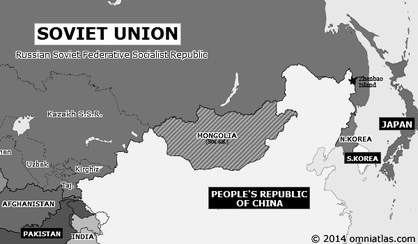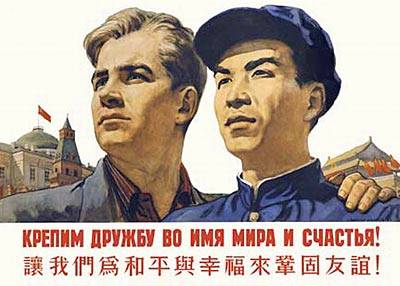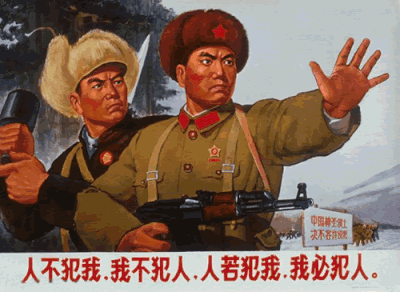|
The location of Battle of Zhenbao Island
|
Influence from Soviet Union In the 1960s, the relations between China and the Soviet Union were strained due to long-term ideological differences and territorial disputes. By 1969, armed conflicts exploded along the two nations' 4000-mile common border[1][2]. |
|
[2]Chinese Political Propaganda Poster: Left-1950s–"Let us keep friendship for peace and happiness" [referring to Chinese friendship with the Soviet Union] Right-1960s–"We will not attack unless we are attacked; if we are attacked, we will certainly counterattack." [referring to territorial conflicts with the Soviet Union] source: Sino-Soviet Picture Poster. Fenghuang |
The breakdown of the Sino-Soviet alliance provided an opportunity for Sino-American relations to improve. Chinese leaders wanted more meaningful relations with the U.S. to relieve the Soviet pressure. At the same time, President Nixon hoped that approaching would offer America strategic advantages in the Cold War[3].
[3]
“We simply cannot afford to leave China forever outside the family of nations, there to nurture its fantasies, cherish its hates and threaten its neighbors. There is no place on this small planet for a billion of its potentially most able people to live in angry isolation”
-Richard Nixon. Foreign Affairs. 1967.
Interview Section: Two Nations' Consideration:
|
"The U.S.’s decision to move closer to China was therefore seen as a diplomatic move that could achieve two goals. One was to draw closer to China so that the U.S. could gain leverage in its relationship with the Soviet Union. The other was to use Chinese influence and power to help broker a cessation of hostilities in Vietnam.“ |
|
|
|
Jiayong Lu | Senior Division
Website Individual 2018 NHD 2nd Place Winner |
website word count:1197 words process paper word count: 474 words video length: 3 min 55 sec |




